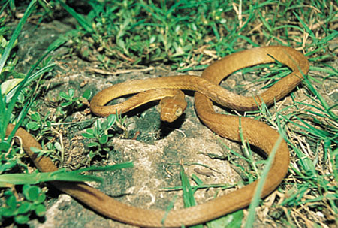Snake Venom
Biology 342 Fall 06 Trevor Young
The evolution of the mechanism of venom delivery
The selection pressures behind the evolution of a venom delivery mechanism are thoroughly covered in an article by Alan Savitsky [1]. Savitsky hypothesizes that among early snakes the development of an inertial feeding mechanism (where prey is swallowed whole by the snake) initially led to a development of constriction as a means of subduing live prey. However due to environmental changes in North America during the middle to late Miocene era, savannas became more prevalent, rendering the ambush strategy of early constricting snakes ineffective due to the lack of cover. This environment favored rapid movement which was incompatible with a constricting snake’s musculature. This environmental change caused an evolutionary shift which started selecting more for a musculature suited for chasing prey than a constricting musculature. This also selected for the development of an alternate method of subduing live prey, which led to the development of the Duvernoy’s gland as a venom producing gland. Savitsky theorizes that the development of the Duvernoy’s gland as a venom secretion system allowed the rapid divergence of venom production and delivery systems seen in the fossil record.
While the
original function of the Duvernoy’s gland is unknown, a recent paper [2] has theorized that the
Duvernoy’s gland served to detoxify carcasses infested with microbes and their
toxic byproducts. This theory is strengthened by previous research which
shows that bacterial activity is inhibited by snake oral secretions [3]. Shivik (2006) also points to the brown tree snake as an
example of this phenomenon, which mainly kills its prey by constriction but
also scavenges, and has retained a functioning Duvernoy’s gland which has been
lost in some constricting snakes. Shivik postulates that the Duvernoy’s gland was
retained as an example of his theory of the Duvernoy’s gland serving to
detoxify the carcasses the brown tree snake scavenges.

Brown Tree Snake (Courtesy of USGS).
Resources cited in this section:
1. Savitzky, A.H. The role of venom delivery strategies in
snake evolution. Evolution 34, 1194-1204 (1980).
2. Shivik, J.A. Are vultures birds, and do snakes have venom, because of macro- and microscavenger conflict? Bioscience 56, 819-823 (2006).
3.Thomas, R.G., & Pough, F.H. The effect of rattlesnake
venom on digestion of prey. Toxicon 17, 221–228 (1979).
4. Jansen, D.W. A possible function of the secretion of
Duvernoy’s gland. Copeia 1, 262–264 (1983).